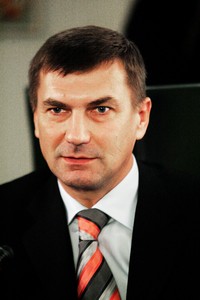
MOSCOW ASSAILS ESTONIA ON DEPORTATIONS ANNIVERSARY DATE
Publication: Eurasia Daily Monitor Volume: 4 Issue: 60
By:

On March 25 Estonia, Latvia, and Lithuania commemorated the mass deportations to Siberia that were carried out on that date in 1949 by Soviet Russian authorities. Some 95,000 people were deported that day from the Baltic states, including more than 20,000 from Estonia alone, a decimated nation of less than one million at that time. All the arrests were carried out at night and the deportations were ordered without any judicial procedure or appeal in the framework of the Priboy operation.
In the lead-up to the commemorations and afterward, Russia’s government and Duma chose to assail Estonia for its intention to remove the bronze monument to the “Liberating” Red Army Soldier from downtown Tallinn.
Estonian Prime Minister Andrus Ansip confirmed that intention on March 22, along with recommendations by the Defense Ministry’s War Graves Commission to excavate around the base of the monument and transfer any remains of Red Army soldiers that might be found there to a war cemetery for re-burial with military honors.
“Such actions would seriously affect Russia-Estonia relations,” Russian Minister of Foreign Affairs Sergei Lavrov warns. He is calling on the European Union and NATO to “raise their voice against such steps in Estonia.” Those are clearly the wrong addresses for such recriminations, but Moscow is using this tactic constantly against the Baltic states on a variety of issues in attempting to portray them as hindrances to West-Russia relations.
Russia’s MFA and the embassy in Tallinn are publicly calling for talks on preserving the Red Army monument, but only if Estonia first cancels its decisions that permit the monument’s removal. This precondition would mean rescinding the legislation passed in January by parliament that has authorized the Bronze Soldier’s removal from downtown Tallinn to a less conspicuous location in a military cemetery.
Four major parties in Russia’s Duma — the governing United Russia, the Communist Party, the ultranationalist Liberal Democratic Party of Vladimir Zhirinovsky, and the red-brown People’s Will of Sergei Baburin — have similarly denounced the Estonian authorities’ decision and imagined “neo-Nazi tendencies” in that country. The four parties have decided to form a standing inter-party conference on foreign policy, place this issue high on the commission’s agenda, and hold public actions in defense of the Tallinn monument. The joint document obliquely disavows economic sanctions “because honor and dignity must prevail over everything else” — or perhaps because interests of businessmen connected with these parties must prevail over much else.
However, “the need to save Russia’s face” is uppermost in this dispute with Estonia, according to the Duma’s international affairs committee chairman Konstantin Kosachev (Regnum, March 26). At odds with the Duma’s and MFA’s position on this issue, Kosachev told a session of those four parties’ foreign policy conference that the removal of the Red Army’s monument from Tallinn is inevitable and must therefore be perceived to occur not against Russia’s will, but rather with Russia’s permission and in a dignified manner, indeed with Russia participating in the ceremonies.
Thus, Kosachev calls for holding negotiations with Estonia along these lines. In any case, Estonian Minister of Foreign Affairs Urmas Paet anticipates that the Bronze Soldier and any nearby graves would be removed in full dignity and on the basis of Estonian legislation and relevant international conventions.
Local Russians in Tallinn who insist on keeping the monument in place claim that some Soviet soldiers are buried underneath and that therefore the Bronze soldier is in effect a marker of military graves, purportedly not subject to relocation. This claim was not advanced during the Soviet Russian occupation or since then, however. Even during the occupation period, the authorities treated the site somewhat cavalierly. At present, local Russian activists of the Nochnoy Dozor (Night Watch) and other groups are warning that they could thwart the on-site excavation that the authorities plan to conduct in order to ascertain whether war dead are buried there. Apparently those activists calculate that uncertainty on that matter could keep the monument in that place longer or indefinitely.
The Russian government’s attitude to this issue (as on many other issues related to the recent history of Soviet occupations and crimes) reflects the government’s unwillingness to face the full implications of Russia’s legal succession to the USSR. The Russian Federation is heir not only to the USSR’s material assets and liabilities and legal titles, but also the heir to Soviet crimes. That complex legacy is an indivisible one as in any state succession.
At the societal level, moreover, Russia has not experienced the post-totalitarian process known in post-totalitarian Germany as Vergangenheits-Bewaeltigung, the paradigmatic “coming to terms” with history, including its crimes. Absent such coming to terms, many Russian officials and citizens tend to confuse occupations and annexations with liberations, cling to symbols of brutal conquest as attributes of national prestige, and seem startled when confronted with these issues. The aborted coming to terms with Soviet history is casting shadows on Russia’s relations with its neighbors.
(BNS, March 23-26)




